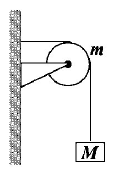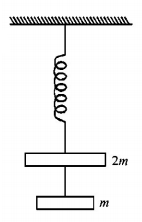Question
A triangular block of mass $$M$$ with angles $${30^ \circ },{60^ \circ },$$ and $${90^ \circ }$$ rests with its $${30^ \circ } - {90^ \circ }$$ side on a horizontal table. A cubical block of mass $$m$$ rests on the $${60^ \circ } - {30^ \circ }$$ side. The acceleration which $$M$$ must have relative to the table to keep $$m$$ stationary relative to the triangular block assuming frictionless contact is
A.
$$g$$
B.
$$\frac{g}{{\sqrt 2 }}$$
C.
$$\frac{g}{{\sqrt 3 }}$$
D.
$$\frac{g}{{\sqrt 5 }}$$
Answer :
$$\frac{g}{{\sqrt 3 }}$$
Solution :
$$\eqalign{ & ma\cos {30^ \circ } = mg\sin {30^ \circ } \cr & \therefore a = \frac{g}{{\sqrt 3 }} \cr} $$

$$\eqalign{ & ma\cos {30^ \circ } = mg\sin {30^ \circ } \cr & \therefore a = \frac{g}{{\sqrt 3 }} \cr} $$



